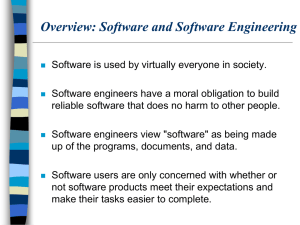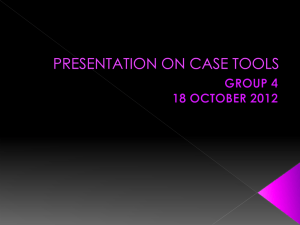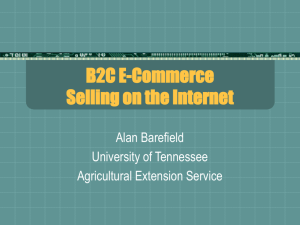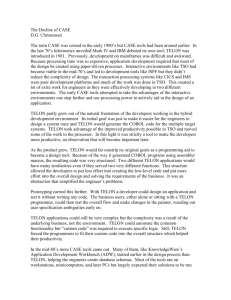Chapter 1
advertisement
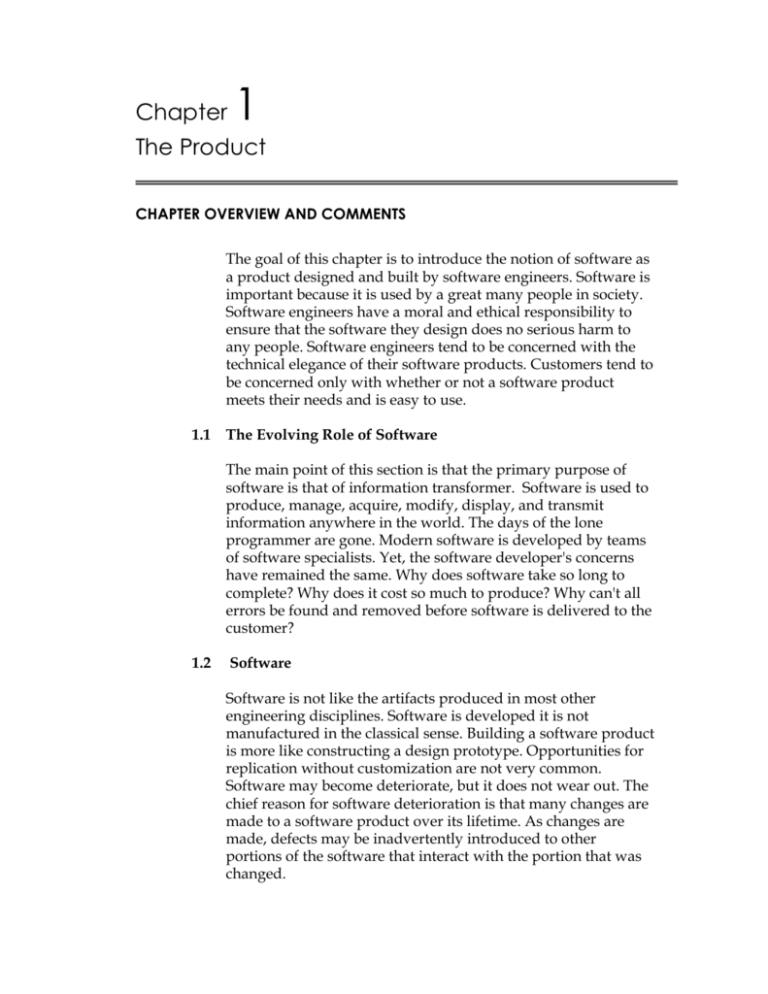
Chapter 1 The Product CHAPTER OVERVIEW AND COMMENTS The goal of this chapter is to introduce the notion of software as a product designed and built by software engineers. Software is important because it is used by a great many people in society. Software engineers have a moral and ethical responsibility to ensure that the software they design does no serious harm to any people. Software engineers tend to be concerned with the technical elegance of their software products. Customers tend to be concerned only with whether or not a software product meets their needs and is easy to use. 1.1 The Evolving Role of Software The main point of this section is that the primary purpose of software is that of information transformer. Software is used to produce, manage, acquire, modify, display, and transmit information anywhere in the world. The days of the lone programmer are gone. Modern software is developed by teams of software specialists. Yet, the software developer's concerns have remained the same. Why does software take so long to complete? Why does it cost so much to produce? Why can't all errors be found and removed before software is delivered to the customer? 1.2 Software Software is not like the artifacts produced in most other engineering disciplines. Software is developed it is not manufactured in the classical sense. Building a software product is more like constructing a design prototype. Opportunities for replication without customization are not very common. Software may become deteriorate, but it does not wear out. The chief reason for software deterioration is that many changes are made to a software product over its lifetime. As changes are made, defects may be inadvertently introduced to other portions of the software that interact with the portion that was changed. 1.3 Software: A Crisis on the Horizon Many people have written about the "software development crisis". There seems to be an inordinate fascination with the spectacular software failures and a tendency to ignore the large number of successes achieved by the software industry. Software developers are capable of producing software the functions properly most of the time. The biggest problem facing modern software engineers is trying to figure out how to produce software fast enough to meet the growing demand for more products, while also having to maintain a growing volume of existing software. 1.4 Software Myths The myths presented in this section provide a good source of material for class discussion. Managers need to understand that buying hardware and adding people does not spontaneously solve all software development problems. Customers need to understand that computer software does not make all their other problems go away. If the customer can not define his or her needs clearly, it is not possible to build a software product to meet these needs. If a customer does not have defined business processes without computer support, building computer software will not create these processes automatically. Software engineers must be committed to the concept of doing things right the first time. Software quality does not happen on its own after a product is finished. Quality must be built into every portion of the software development process. PROBLEMS AND POINTS TO PONDER 1.1. Classic examples include the use of "digital automobile dashboards" to impart a high tech, high quality images. Appliances that "think;" the broad array of consumer electronics; personal computers (today, differentiated more by their software function than the hardware), industrial instrumentation and machines. All e-commerce applications are differentiated by software. 1.2. The apprentice/artist culture of the 1950s and 1960s worked fine for single person, well constrained projects. Today, applications are more complex, teams work on large projects, and software outlives generations of developers. Yet, the culture established in the early days dies hard, leading more than a little resistance to more disciplined methods. In addition (see Chapter 29), the new generation of Web application developers is repeating many of the same mistakes that programmer made during the circa 1965. 1.3. This is a good problem for classroom discussion (time permitting). Rather than focusing on cliche' ridden (albeit important) issues of privacy, quality of life, etc., you might want to discuss "technofright" and how software can help to exacerbate or remedy it. Another interesting possibility is to use Neumann's "Risks" column in SEN to key discussion. You might also consider new attempts at software-based ‘cash’ economies, new modes of interactive entertainment, virtual reality, e-commerce, etc. 1.5. There are literally dozens of real life circumstances to choose from. For example, software errors that have caused major telephone networks to fail, failures in avionics that have contributed to plane crashes, computer viruses (e.g., Michaelangelo) that have caused significant economic losses. Attacks on major e-commerce sites. 1.6. The two broadest categories encompass risks associated with economic loss and risks to the wellbeing of people. You might suggest that each student select five risks (culled from the sources noted) and present them to the class. Encourage them to look for humorous as well as serious risks. 1.7. To be honest, most professors do not assign papers as part of software engineering courses that use SEPA. Instead, a term project (or a number of somewhat smaller projects) are assigned. However, you might consider discussing software engineering issues as they relate to the topics noted in this problem. 1.8 Another way to characterize this problem is to suggest that each student describe a software myth that he or she believed that has subsequently been dispelled. From the student's point of view, myths will likely be driven by programming projects that they've attempted earlier in their career. To give this problem a contemporary feel, you might consider the myths that have evolved around the development of Web-based applications.
